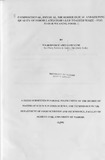Compositional, physical,micorocrobiological and keeping Quality of formulated dehulled toasted Maize-egg Flour weaning Food.
Abstract
Dehulled Toasted Maize - Egg Flour (DTMEF) , a cereal-based food for infants and young children
made from dehulled maize, was prepared by a procedure in which millet amylase rich flour (MARF)
( for viscosity reduction) was incorporated to dehulled toasted maize flour (DTMF) - dried whole
egg powder (DWEP) porridge at levels of 2-8%, as a means of determining the level at which it could
be added to the mixture in the dry form. The objective was to have a final product of lower dietary
bulk.
There was no significant difference between the viscosity reduction percentages at 2, 4, 6 and 8
percent MARF level. For economic reasons, a 2% MARF level was chosen. At this rate of usage,
viscosities obtained compared well with the recommended range of 1,000-3,000 cl'.
Physico-chemical and microbiological properties were determined as an evaluation of the product's
quality. It was low in moisture (3.2%), an indication of good storage stability, high in protein (17.9%)
and fat (10.3%) with a calcium content of 57.2 mg/IOO g and energy content of 423 Kcalll00 g.
These results compare well with the Protein Advisory Group (PAG) guidelines for weaning foods
which recommend that the protein content should be at least 20% (on a dry weight basis), fat levels
up to 10%, moisture 5 to 10%, and total ash not more than 5%. It had a neutral pH (7.1). Its yeast
and mould count, expressed as 'the logarithm to base ten of the colony forming units per gram of
sample, was low (3.3) and Salmonella was undetected. These results are a good indication that the
developed weaning food is likely to supply (to a greater extent) the protein and energy requirements
of weaning children if adopted for feeding.
viii
Citation
MSc.Sponsorhip
university of NairobiPublisher
University of Nairobi Department Of Food Science and Technology

